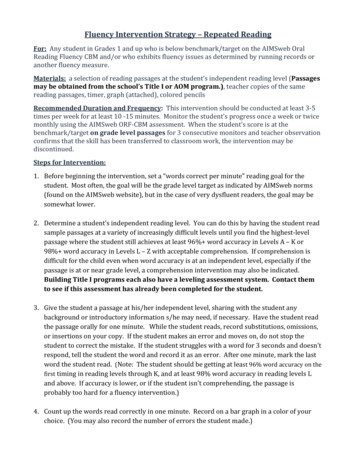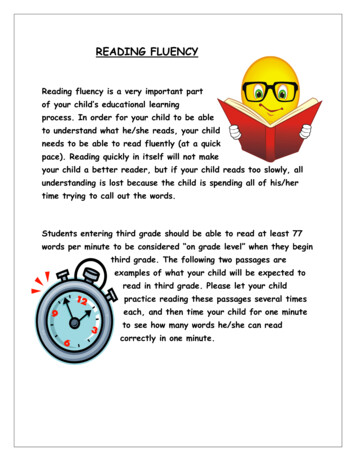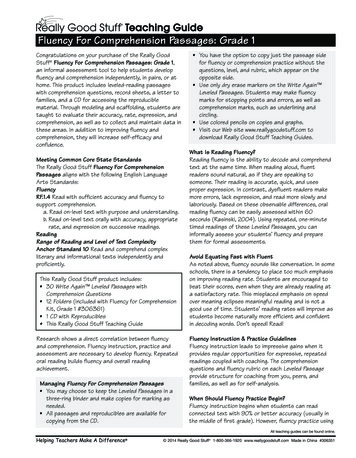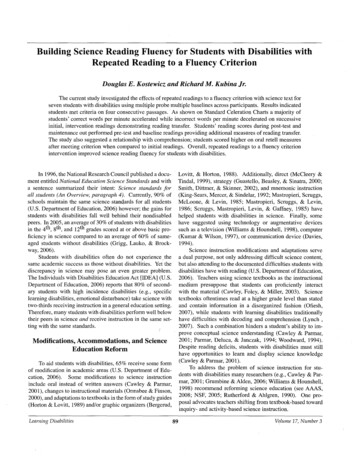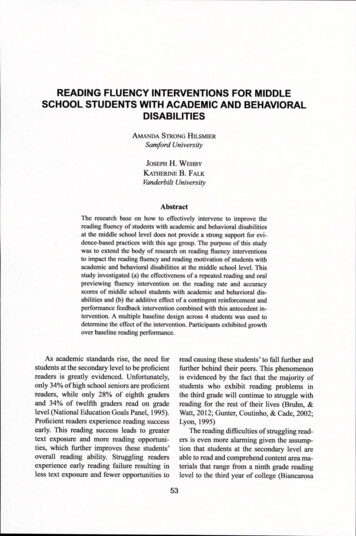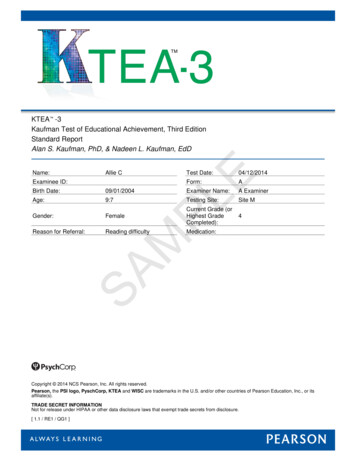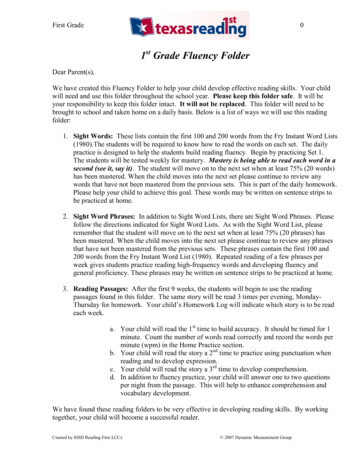
Transcription
1A Fluency &TechnologyLearning Centerfor StrugglingReadersKaren SmallMAE/Reading Endorsement K-12Key WordsFluency, struggling readers, learningcenter, technology, timed repeatedreadingAbstractThe purpose of this action research was to investigate the success of using a combinationof fluency strategies for intermediate grades in a self-directed learning model/center.This investigation sought to document the effectiveness of such a model/center throughtimed reading rate charts, journals, repeated reading, observation, and running records.The findings of the research revealed positive growth for the students in fluency,comprehension and reading rates. Furthermore, the multi-task student-directed modelinstilled confidence in the students; the addition of electronic books added extra focus forone of the students and more time for the teacher. The self-directed learning modelincreased student reading and fluency skills as well as allowed more effective timemanagement for the teacher.Table of ContentsA Fluency & Technology Learning Center for Struggling Readers . 1Introduction . 2Research . 3Timeline Plan . 4Exploratory Studies . 5The Change . 7Case Studies . 8The Question . 11Conclusion . 15References . 16
2IntroductionI am a graduate student at Otterbein College in Columbus Ohio. I have been involved insome form of education for most of my life in one way or another. I started a babysittingservice when I was 11 and maintained it through college. I was an avid reader to myyoung charges. I read Bible stories at church and told stories of Native American cultureduring Saturday School at The Ohio State University (OSU). I graduated with a degreein Art Education and taught in four different schools before returning to OSU to pursue adegree in Elementary Education. I returned to the field as a substitute teacher havingvaried and interesting experiences with teaching. However, through the best and worst ofthese experiences students responded positively to reading, particularly being read to. Asa result of my positive experiences with literacy, I decided to expand my qualifications inthe field by pursuing my Masters Degree in Reading.In the course of my graduate studies over the past few years, I have worked in severalclassrooms as a “reading intern”. In each class, regardless of the district or the classroomI observed that there were students who seemed to “fall through the cracks,” studentswho were by all accounts struggling with reading but not enough to merit additionalsupport outside of the classroom. These students were painful to watch as they laboredover each word. In some cases they would just stare at the page and look as if they wouldcry. These students would articulate that they were just very poor readers and actuallyapologized to me. This was all in all more than I could stand. No child should have to beso disconnected from reading!In my past experiences with struggling readers I was intrigued by readers who couldbarely decode a word yet comprehend most if not all of what they read. On oral readingassessments these readers would test at a frustration level with significant miscues and
3then score 100% on a comprehension test on the text. This was a mystery to me andseemed to be something that should be easily fixed. I felt these struggling readers had itin them to improve. They“Fluency is of little value in itselfunderstood what they were readingbut struggled pronouncing the wordsits value lies in what it enables.”in the text. They wanted to be more(Samuels & Farstrup, 2006).fluent readers; they tried so hard thatthey would repeatedly reread thingsthey had read correctly the first time. To me it seemed they possessed the most importantaspect of literacy- comprehension- but lacked confidence in their reading. I decided thatI wanted to find a way to help intermediate struggling readers become more confidentand fluent readers.ResearchFluency has been identified by many researchers and educational organizations as a veryimportant aspect of reading success. The National Reading Panel (2000) identifiedfluency to be a key component of effective reading instruction. The National Institute forLiteracy (2009) says, “Fluency is the ability to read a text accurately and quickly. Whenfluent readers read silently, they recognize words automatically. They group wordsquickly to help them gain meaning from what they read. They read aloud effortlessly andwith expression. Fluency is important because it provides a bridge between wordrecognition and comprehension”. As I reviewed research on fluency, I focused myattention on repeated reading techniques, which appeared to be effective for the types ofstruggling readers I had known.Timothy Rasinski (2003) identifies many advantages of repeated reading such asimproved comprehension and “faster reading with greater word recognition accuracy”(p.77). Other researchers (Chomsky, 1976; Dowhower, 1987; Samuels, 1979; Samuels &Farstrup, 2006) identify greater gains in fluency and comprehension through repeatedreading techniques. LaBerge & Samuels (1974) made a case for repeated reading andused the theory of automaticity (the ability to perform a task without significant demandson attention) to support the concept. All of the experts cited above advance the notionthat excellent readers decode with ease; through repeated readings a struggling reader canswitch attention from decoding to meaning. Yet, as I continued my study of evidencebased practice related to fluency, I found that the most progressive and effective learninginvolved a combination of reading strategies rather than one single method.I decided to use The Basic Reading Inventory (Johns, 2005) to establish baseline readingrates. I then planned to combine repeated reading with fluent modeling (Strickland,2002), decoding skills and sight word identification (Archer, 2003; Beers, 2003), runningrecord analysis (Clay, 2002), high frequency vocabulary words (Hudson, 2005), readingjournals (Fountas & Pinnell, 2001) and technology (Kamil, Intrator & Kim, 2000).Modeling made sense, as students would hear the correct way to read the text. Decodingpractice would strengthen their fluency skills during their oral reading. Sight words had
4to be addressed to give a stronger foundation for reading familiar words, and runningrecords (Clay, 2002) would help me gain insight into the strategies that students wereusing (Rasinski, 2003). Reading journals gave students opportunities to write about theirprogress and provided kinesthetic reinforcement (Buus, 2005). Finally, technology hasbeen shown to bring reading and writing together for students in a holistic way (Kamil,et. al., 2000). I was ready to use all of these tools in a learning center.Timeline PlanI worked with five students over a two-year period. During this time I explored variousstrategies for improving fluency. Following these explorations, I drew upon myexperiences and evolving understandings about fluency to design a logical systematicintervention for two target students. The end result was a final case study of two studentsthat was conducted in a public suburban school library, a school computer lab, and a selfdirected learning center in the students’ classroom.BackgroundPrior to starting the final case study I conducted informal research on three students, all inthe intermediate grade levels. I worked with two girls and one boy, grades four and five.Subsequently, I conducted my final case study on two students from the second grade;one boy and one girl. The students were from diverse backgrounds (see Table 1-below).The thing they all had in common was a problem with fluency. These students were allreading below their grade level (see Table 1-below). Additionally, it is important to notethat when these students entered into the intermediate grades external support in readingwaned. They were at risk for falling further behind. For these reasons I selected them formy action research.
5Table 1Student Demographics for Fluency Center ResearchSTUDENTAGEGENDERETHNICITYACTUALGRADE LEVELat time of testGRADE LEVEL TESTEDWCPMBasic Reading Inventorypercentile scores (Johns, Preassessment test)ALAYA9FEMALEAFRICANAMERICAN4TH GRADE70% of 3RD GRADERAVEN9FEMALEAFRICANAMERICAN4TH GRADE36% of 3RD GRADETRENT10MALECAUCASIAN5TH GRADE28% of 5TH CAN2ND GRADE40% of 2ND GRADE**CASESTUDY-(2)MASON8MALECAUCASIAN2ND GRADE70% of 2ND GRADEExploratory StudiesMy exploratory studies involved three students from the fourth and fifth grade level, oneCaucasian boy and two African American girls from diverse suburban public elementaryschools.Instructional proceduresI focused on applying Rasinski’s Repeated Reading (1990) protocol. This techniqueincludes the following steps: 1) text is given to the student/s; 2) student/s follow along asteacher reads the text; 3) teacher and student/s do choral reading; 4) student/s practicerereading the passage three times: 5) teacher and student/s pick three or four words to addto their word bank; 6) student/s engage in word activities.I gave the students a passage of 100 words at their grade levels and then had them followalong as I modeled fluent reading of the text. Then I would have the student/s choral readalong with me. Finally, I would have them orally reread the same text and time each oftheir re-readings.
6For word activities I used word searches, flashcards, word definitions, and word banks onvocabulary within the passages. I found the repeated readings protocol changed thestudents’ fluency but not as much as I had expected.Alaya and RavenMy first two students (Alaya and Raven-4th graders) scored at the frustration level on theBasic Reading Inventory (Johns, 2005) for fourth grade and instructional level for thirdgrade. On the pre-assessment they scored at the 70th and 36th percentiles on the thirdgrade passages for WCPM. The two fourth grade girls both had fluency challenges.Overall, I found that fluency was lagging behind comprehension.A problem arose as I noted their repeated reading times were getting longer not shorter.The research on repeated readings (Rasinski, 2003) indicated that repeated readings leadto faster reading rates. In the case of these students, repeated readings appeared to lead toincreased reading rates. Raven would add five to ten seconds onto her repeated readings,and Alaya would increase by ten to fifteen seconds. Following Rasinski’s protocol, Iwould model the text and then allow each student to read it a few times (while I timedeach read). These two exploratory students continued to add on time with three and fourre-readings- I was frustrated and concerned. A third exploratory student was about tobegin the same intervention.TrentTrent was a fifth grader, a quiet young man. I gave the three students a survey on theiropinion about reading and its importance in their lives. The girls wrote it was veryimportant and they would use it later in life, but Trent wrote it was of no importance nowor later. I used the same BRI pre-assessment as I had for the girls. Trent scored at afourth grade instructional level and reached frustration on the fifth grade passage. Hisreading rates were 40th Percentile for one grade below and 28th Percentile for his owngrade level on WCPM. I engaged Trent in the repeated reading protocol. Trent, like thegirls, added five to fifteen seconds time on his repeated readings.Additionally, I was using comprehension questions, guided reading, prior knowledge, andsupport with prompting with all three students. I added these strategies when I saw thatthe basic repeated reading technique wasn’t working. I hoped this would help theirreading rate, but the rates did not increase.Then one February day I was about to model and stopped. I wondered what Trent wouldbe able to do if he had no model first. I just wanted to get a feeling of where he was onhis own. So, I asked him to read aloud first this time. I called it a “cold reading.” Heseemed puzzled, but complied. He read at about the same speed as he had for other firstreads. I told him to listen while I read the text and read along silently. Then I asked himto read again, and something happened. Instead of adding seconds, his rate of readingtime was cut in half! His prosody was also improved! We were reading a slightly longertext which took him a painful four minutes to read the first time, but only two minutes thesecond. His miscues also diminished drastically; he went from fourteen miscues in thefirst reading to three on the second.
7His expression was smoother and more confident. I decided to have all three students usethis format and do a “cold oral reading” of their own before I modeled. All three studentsimproved their times and reduced their miscues by half or more. I was close to the end ofmy time with them, but they had raised their levels by 20% or more.I gave each student an exit survey where I asked them to choose how important readingwould be to their lives both now and in the future. The exit survey was quite telling.Trent stated he now believed reading was important and would continue to be importantin his life when he got older. He had a sense of possibility about his reading he did nothave when he started. Trent agreed to continue the same format at home with a familymember who would model after his “cold read.”The ChangeConceptI decided to apply the technique of “cold reads” to my Case Study interventions. Iwanted to find research that would support this idea of a “cold read” before modeling as avalid technique. I wondered why the change to a “cold first oral read” by the student,followed by the fluent teacher modeling (instead of the fluent teacher model first) hadmade a difference. The research was not easy to find, but I came across some interestinginformation that I thought may be the reason the “cold read” first made a difference. Theresearcher, Lauree M. Buus (2005), was looking at the effect journaling would have onReading Comprehension. I found information in Buus’s article on memory, particularlyits function in a child’s capacity to learn. And what I was reading made me think thismight be a reason the change had made a difference. The concept that interested me wassomething the researchers called “working memory.” My frustration had been that mystudents didn’t seem to remember what they had heard when we did the protocol withteacher modeling first. They did not apply any changes to their fluency and took longerto read the passages. Turkington & Harris (2001) identify memory as having threeseparate stages. I had prior knowledge of this fact, but what I found interesting was howthey framed short-term memory as “working memory” and referred to it as a “mentalwork space” (p.256). They explained that we use this work space to sort and decodeinformation before adding it to long-term memory. Hudson & Gillam (1997) discusshow the degree of participation and discussion of an event during the event can affect theencoding of information. I believe the students were able to encode the new informationgiven in the fluent model after the cold read and make an adjustment to their ownreading. In other words, I think they were able to hear the difference between theirproduction and my production. They were able to use their “working memory” moreefficiently as a result.Topping identified “metacognition” as a key component in fluency (Samuels & Farstrup,2006). Webster’s New Millennium Dictionary defines metacognition as “awareness andunderstanding one’s thinking and cognitive process.” The students were able to get
8immediate feedback on their cold read and think about what they would do to correcttheir errors. I took this concept of a “cold read” before fluent modeling as the newapproach to repeated reading intervention. I incorporated this change in strategy with myfirst case study student, a second grade student with strong desire to help me in thisproject and to become a better reader.Case Studies1st Case Study-AnnaMy first case study student was an eight-year-old, second grade female named Anna. Sheattended a diverse suburban school. Anna was a sweet polite girl with wide eyes, whosefamily was Indian. Her teacher said she was not able to keep up with a small-groupreading intervention, and believed Anna would benefit from one on one intervention.I gave Anna the BRI; she scored at frustration level for WCPM on the second gradepassage and at the instructional level on the second grade word list (see Table 2-below).Anna took a reading opinion survey and indicated that reading was very important to herlife both now and in the future. She told me she wanted to become a better reader.
9Table 2BRI Results: AnnaGradeStudentPassageLevelOral ReadingAccuracyComprehensionWords Per MinuteAnna2ndA2FrustrationIndependent40 - (Pre- Test)Anna2ndD1InstructionalIndependent72 - (Mid- Test)Anna2ndD2Ind./Inst.Independent100 - (Post-Test)Anna struggled with words and had little or no prosody, but she had good comprehensionof what she read. I hoped that the modified repeated reading protocol would benefit herlike it had the other three students. We started working with the same format; she woulddo a “cold read,” then I would model a fluent read; finally, she would read again.I timed each of her readings and kept running records. I allowed Anna to journal aboutour work, writing about what she learned and what she felt she had accomplished. Itaught her how to time and chart her own progress (see Figure 1-below). This allowedsome release of responsibility from the teacher to the student (Manning, 1999), so thatshe could become self-directed in the fluency center. Anna loved to time herself with thestopwatch! She created her own chart and plotted her progress on a graph.
10Figure 1Anna’s Fluency Graph of Repeated Reading Times(Anna’s 1st read times did not rise above the baseline she set of 70wpm until week four)At first Anna sighed and paused a lot; she also had multiple miscues (substitutions thatwould change meaning, omissions, substitutions, reversals etc.). Anna was nervous aboutreading aloud, displayed little confidence, and would consistently reread passages shehad read correctly (sometimes multiple times). Anna’s pre-assessment showed she readat a rate of 40 WCPM. She wanted to become a better, more fluent reader. Furtherassessment showed her repeated reading scores rising, but the first “cold reading” timedid not rise as fast as the second or repeated readings (see Table 3-below).My hope was to see Anna’s first “cold reading” times come up to meet her “second read”times. Our goal was to reach 100 WCPM in the first oral “cold readings” using 100 wordpassages at her grade level (2nd grade), and finally to score 100 WCPM on the BRI postassessment 2nd grade level passage. I showed Anna the Spring, 2nd grade level standardsfor WCPM. She wanted to go beyond the high level of 94. She felt she could do it. Wealso set our goal to be 100% on Miscues using the BRI assessment at the 2nd grade level.Anna achieved all of her goals (see Table 3a.-below). She accomplished this in sixteensessions over eight weeks. Anna worked hard for this study and made significant gains.
11Table 3Repeated Reading Times: Anna1st ReadCold Reading2nd ReadPost-Modeling1. 451. 742. 342. 943. 413. 854. 404. 985. 615. 1056. 586. 1047. 627. 1158. 608. 1139. 529. 10410. 5710. 10911. 7611. 10812. 8012. 14813. 8213. 16414. 8814. 15815. 9415. 16016. 9016. 150Table 3a.Pre-Test, Middle & PostAssessment - BRI: Anna1009080706050403020100WCPMMISCUESPREMIDPOSTThe QuestionTeachers never have enough time to apply one-on-one intervention techniques, and thisfact informed the idea for the rest of my action research. The question: Could there be away to create a student-directed fluency center using these same techniques to helpstruggling readers become more fluent readers and help teachers with time? Since “timeis of the essence,” I wondered if technology could help. I wanted to take the same modelI had developed in my first case study and add a technology component. I planned to use
12electronic books with my second case study, and expected there to be more books inelectronic CD-Rom format than I was able to find. However, I discovered that some CDaudio books work on the computer as well. I worked with books I could find in eitherDVD or CD-Rom format. I started this plan with my second case study. I explained theformat of using the computer and timed repeated readings to my new student. He wasvery excited at the idea of using the computer.2nd Case Study-MasonMason was a second grader with busy eyes. He had recently moved into a new suburbanpublic elementary school. This school had a diverse population. Mason seemed to havea problem focusing, but his teacher was unsure of whether or not he had an attentiondeficit. She felt there was something else distracting him (maybe his new life and newschool). Mason had a BRI pre-test score of 58 WPM at 2nd grade level. Hiscomprehension was good from the beginning; we used the BRI comprehension tests foreach passage he was tested on. He started with an 82% on the BRI for comprehension.I hoped the computer would be a good way to focus Mason. He was drawn to thecomputer like a magnet. It really focused him in on the task, as opposed to when he wasusing a CD player, (where he looked around the room and wiggled). Mason did not needtext on the screen; audio markers within the computer screen held his attention just aswell. He was using the audio, reading along in the book and staying focused. When Ifirst worked on coaching him in the fluency model I had to constantly refocus him;however, using the computer with the book or audio CD seemed to be very helpful.
13Mason had an aptitudefor all thingstechnological. I wasworried that hewouldn’t be able tohandle timing himselfwith a stopwatchwhile working thecomputer andlistening, but Masonwas very good atmulti-tasking.Although Mason hadno computer at home,he took to it like a pro.Mason’s BRI pre-assessment reading scores for 1st grade were at instructional level, andat the frustration level for 2nd grade (see Table 4-next page). His BRI reading rate scorewas 70 wpm for 2nd grade level. His BRI post-assessment score for word analysis wasindependent at 1st grade level and instructional at 2nd grade level. He scored a BRIreading rate of 120 wpm for 2nd grade level on his post-assessment. Mason showedsignificant improvement in his rate of reading between first “cold read” and secondreading (see Table 5-next page). He loved the computer component which served as hisfluent model. Mason was self-directed in the fluency center. Most notable was hisimproved attention span with the addition of the computer and technology.(Table 4)BRI Results: MasonStudentGradePassageLevelOral ReadingAccuracyComprehensionWords Per dB2Ind./Inst.Independent92Post-Test
14Table 5Reading TimesstFigure 2nd1 ReadCold Reading2 ReadPostModeling1. 501. 1602. 312. 1773. 813. 1534. 554. 1555. 965. 1156. 1426. 1677. 757. 1808. 898. 1909. 759. 19010. 11510. 18511. 2411. 15512. 6312. 165Mason’s Fluency GraphMason was absent for one week during the intervention which affected his baseline onthe graph (see Figure 2- previous page). His first reading (“cold read”) scores are on thebottom, with second read scores on the top line. The goal was to get the bottom line toreach the top line and stay constant. Then he would be reading his first “cold reads” atthe same rate as his second readings (without benefit of the fluent model) which wouldshow he was retaining the ability to read faster on his own.Mason had started to reach the top line and run constant in the third and fourth week(where he spiked at 145 WPM using 1st grade text and 110 WPM using 2nd grade text).He missed most of one week, started slowly the following week, but picked it back upquickly.
15ConclusionDid the fluency center work? I would argue that the answer to that question is “yes.”The change of using a “cold read” before fluent modeling was successful for acceleratingthe students’ reading rates. The addition of student-created graphs and technologyallowed some release of responsibility from the teacher to the student. I believe thisformat can be tailored to meet a variety of fluency levels. The only drawback may be theavailability of technology. However, the teacher-directed fluent modeling format wouldstill work in the absence of the technology. Since teacher time is often an issue, parentand/or peer partners could also work as fluent models.Does the computer replace the teacher? In my experience, students benefit from beingcoached for a few weeks first and then they can continue the process with computer oraudio-computer as the fluent model. The addition of technology for the fluency centerwill allow self-directed work for students; however it is important to recognize that thestudents need to be monitored on an ongoing basis. Obviously, research on technologyand reading is a “tapestry under construction” (Kamil, Intrator & Kim, 2000, p. 783).“Ah yes, but will it transfer”? I have heard this question from teachers andadministrators. Some might say, “This just shows how important the component ofpractice is.” So, which is it--Transfer challenge or practice makes perfect? I believe theanswer is in the question. The “transfer” can and will occur but only with the practicalapplication of the process, the warehouse for more or less “permanent knowledge is ourlong-term memory” (Levine, 2002, p.93). The continuation of short-term practice islikely to create the permanent knowledge needed for fluency. If it has become“permanent,” is that not transference?In addition to improving their oral reading performance, struggling readers need toovercome their own concerns about their reading. From survey results, I was able toconclude that all participants had limited confidence in their reading at the outset butwere more confident and able to express purposes for reading following the intervention.They responded that reading was very important to their lives both now and in the future.Student-directed learning, along with improved skills that could be documented visuallyon progress graphs, helped to build confidence. Since we pull information from longterm memory to reprocess or reproduce it (Zimbardo, Weber, & Johnson, 2003),continuing this process should develop and increase their reading skills, encouragingthem to see themselves as good readers. The easier it is to read, the more likely it is thatchildren will elect to do so. Practice can make perfect.
16ReferencesArcher, A.L. (2003). Decoding and fluency: Foundation skills for struggling olderreaders. Learning Disability Quarterly, 26, 89-101.Beers, Kylene. (2003). When kids can’t read: What teachers can do. Portsmouth, N.H:Heinemann.Buus, L.M. (2005). Using reading response journals for reading comprehension.Networks: An Online Journal for Teacher Research, tworks/article/view/122/123Chard, D. J., Vaughn, S., & Tyler, B. (2002). A synthesis of research on effectiveinterventions for building fluency with elementary students with learningdisabilities. Journal of Learning Disabilities, 35, 386-406.Chomsky, C. (1976). After decoding, what? Language Arts ,53(3), 288-96,314.Clay, M.M. (2002). An Observation Survey of Early Literacy Achievement (2nd ed.).Portsmouth, NH: Heinemann.Dowhower, S.L. (1987). Effects of repeated reading on second-grade transitional readers'fluency and comprehension. Reading Research Quarterly, 22, 389-406.Fountas, I., & Pinnell, G .S. (2001). Guiding readers and writers (Grades 3-6): Teachingcomprehension, genre, and content literacy. Portsmouth, NH: Heinemann.Gibson, E. J., & Levin, H. (1975). The psychology of reading. Cambridge, MA: MITPress.Gonzales, P.C. et al.(1975). Rereading effect on error patterns and performance levels onthe IRI. Reading Teacher, 28(7), 647-52.
17Griffith, L. W., & Rasinski, T. V. (2004). A focus on fluency: How one teacherincorporated fluency with her reading curriculum. Reading Teacher, 58(2), 126137.Hitchcock, C. H., Prater, M. A., & Dowrick, P. W. (2004). Reading comprehension andfluency: Examining the effects of tutoring and video self-modeling on first-gradestudents with reading difficulties. Learning Disability Quarterly, 27(2), 89-103.Hudson, J.A., & Gillam, R.B. (1997). "Oh, I remember now!” Facilitating children'slong-term memory of events. Topics in Language Disorders, 18(1), 1-10.Hudson, R. F. (2005). Reading fluency assessment and instruction: What, why, and how?Reading Teacher, 58(8), 702-714.Johns, J.L. (2005). Basic Reading Inventory (9th ed.): Dubuque, IA: Kendall / Hunt.Kamil, M.L., Intrator, S.M., & Kim, H.S
timed reading rate charts, journals, repeated reading, observation, and running records. The findings of the research revealed positive growth for the students in fluency, comprehension and reading rates. Furthermore, the multi-task student-directed model instilled confidence in the student
